In the broadest definition, a fossil is the remains of a living thing that lived long ago and that has survived down to the present day by being preserved under natural conditions. The fossils that come down to us are parts of an organism, or remains left behind when the living thing concerned was still alive (the latter are known as trace fossils.) They are formed when dead animals or plants are preserved before they completely decay and eventually become part of the earth's sedimentary rock. In order for fossilization to take place, the animal or plant concerned must be buried in a fairly rapid manner—generally by being covered in a layer of silt. This is generally followed by a chemical process, during which preservation is ensured by means of mineral changes that take place in the original tissues.
 |
This birch fossil from the Paleocene period (65.5 to 55 million years ago) found in Montana is three-dimensional. (left) A 50-MILLION-YEAROLD FROG FOSSIL |
Fossils are the most important evidence of the details of prehistoric life. From various regions of the world, hundreds of millions of fossils have been obtained, and they provide a window into the history and structure of life on Earth. Millions of fossils indicate that species appeared suddenly, fully-formed and with their complex structures, and have undergone no changes in the millions of years since. This is significant proof that life was brought into existence out of nothing—in other words that it was created. Not a single fossil suggests that living things formed gradually, in other words that they evolved. The fossil specimens that evolutionists maintain as "intermediate fossils" are few in number, and the invalidity of these has been scientifically proven. At the same time, some of the specimens depicted as intermediate fossils have actually been revealed as fakes, demonstrating that Darwinists are in such a state of despair as to resort to fraud.
 |
A crab fossil that lived between 38 and 23 million years ago. |
For the last 150 years or so, fossils from excavations carried out all over the world prove that fish have always been fish, insects have always been insects, birds have always been birds and reptiles have always been reptiles. Not one single fossil has pointed to any transition between living species—in other words, from fish to amphibian or from reptile to bird. In short, the fossil record has definitively demolished the theory of evolution's basic claim, that species descended from one another by undergoing changes over long periods of time.
In addition to the information that fossils provide concerning life forms, they also supply significant data regarding the history of the planet, such as how the movements of continental plates have altered the surface of the Earth and what kind of climatic changes took place in past eras.
 |
A 490- to 443-million-year-old starfish reveals that starfish have remained the same for hundreds of millions of years and have not evolved. (right) |
Fossils have attracted the interest of researchers ever since the days of ancient Greece, although their study as a distinct branch of science began only in the middle of the 17th century. This followed the works of the researcher Robert Hooke (author of Micrographia, 1665, and Discourse of Earthquakes, 1668) and Niels Stensen (better known as Nicolai Steno). At the time when Hooke and Steno carried out their investigations, most thinkers did not believe that fossils were actually the remains of living things that had existed in the past. At the heart of the debate over whether fossils were the actual remains of living things lay the inability to explain where fossils were discovered, in terms of geological data. Fossils were frequently found in mountainous regions, although at the time, it was impossible to account for how a fish, for example, could have been fossilized in a stratum of rock so high above sea level. Just as Leonardo da Vinci had previously suggested, Steno maintained that sea levels must have declined over the course of history. Hooke, on the other hand, said that mountains have been formed as the result of warming inside the Earth and earthquakes in the oceanic plates.
 A WINGED ANT THAT LIVED 20 TO 15 MILLION YEARS AGO. Fossils trapped in amber by the hardening of resin also refute the theory of evolution. |
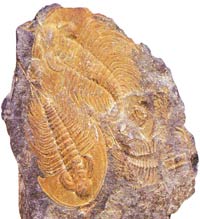
Pictured are a trilobite that lived in the Ordovician period (490 to 443 million years ago) and a gastropod from the Silurian period (443 to 417 million years ago). From these fossils, we can guess that the rocks in question are around 448 to 442 million years old.
Following the accounts of Hooke and Steno, who explained that fossils were actually the remains of living things that had once lived in the past, geology developed during the 18th and 19th centuries, and systematic fossil collecting and research began turning into a branch of science. The principles that Steno had laid out were followed in the classification and interpretation of fossils. From the 18th century on, the development of mining and increased railway construction permitted greater, more detailed investigation of what lay below the ground surface.
Modern geology revealed that the Earth's crust consisted of enormous sections known as "plates," which moved across the surface of the globe, carrying the continents and forming the oceans. The greater the movement of the plates, the more changes in the Earth's geography. Mountain ranges were the result of the collisions between very large plates. Changes and upthrusts in the Earth's geography that took place over very long periods of time also showed that strata that today form portions of mountains were once under water.
In this way, fossils seen in rock strata emerged as one major means of obtaining information about the different periods of the Earth's history. Geological information showed that the remains of living things preserved after death in sediments—fossils, in other words—rose up in rock strata laid down over enormously long periods of time. Some of the rocks in which fossils were found dated back hundreds of millions of years.
 |
1 - Generally following the death of a living organism, first the soft tissues become deformed and decay. Then later, hard parts such as bones and teeth are preserved. Burial should occur fairly rapidly to prevent deformation of the bones. |
 |
A fossil researcher working at the Ediacara Formation in Australia. |
 |
 | |
Geological researches show that layers of the Earth move and mountains were formed as a result of the movements and collisions of large tectonic plates. In the drawing above, the historical formation of Himalayas is depicted. When the region of India started to move toward Euroasia approximately 145 million years ago, the ocean floor slipped under Euroasia. | |
 | 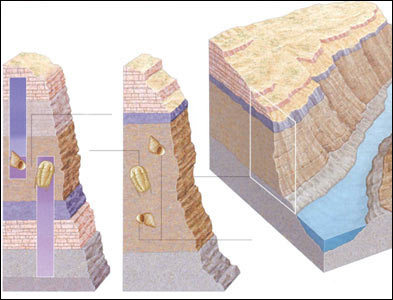 |
(left) A satellite image of the Earth.. | Fossils used to determine the formation dates of rocks are called index fossils. The majority of these species are ones that lived in only a particular period, that were widespread and easily recognizable |
 Fossil findings reveal that the imaginary beings in these drawings have never existed. Living beings appeared suddenly in fossil record, with all their features intact, and throughout their lives these species have undergone no changes whatsoever. | Darwinists claim that by undergoing minor changes, living beings evolve from one species to another over millions of years. According to this claim which is refuted by scientific findings, fish transformed into amphibians, and reptiles transformed into birds. This so-called transformation process, asserted to last for millions of years, should have left countless evidence in the fossil record. In other words, during their intense researches for the last hundred years, researchers should have uncovered many grotesque living beings such as half-fish half-lizard, half-spider half fly or half-lizard half-bird. However, although almost every stratum on Earth has been dug, not even a single fossil has been found that Darwinists can use as an evidence for their so-called transition. On the other hand, there are innumerable fossils showing that spiders were always spiders, flies were always flies, fish were always fish, crocodiles were always crocodiles, rabbits were always rabbits and birds were always birds. Hundreds of millions of fossils clearly show that living beings have not undergone evolution, but were created. Hundreds of millions of fossils prove that living beings did not evolve, but were created. |
During these studies, it was observed that specific fossil species were found only in specific strata and certain types of rock. Consecutive rock strata were observed to contain their own fossil groups, which could be regarded as that particular layer's "signature." These "signature fossils" could vary, according to time, period, and area. For example, two different environmental conditions and kinds of sediments—an ancient lake bed and a coral reef, for example—might be encountered in the same fossil-bearing stratum belonging to the same geologic period. Alternatively, one might encounter the same fossil "signature" in two different rock beds many kilometers apart from one another. Through the information imparted by these remains, scientists determined the geological time frame that we still use today.
 |
A wasp of 54 to 28 million years old, petrified in amber. |
Following the death of a living thing, a fossil comes into being through the preservation of hard body components an animal leaves behind, such as bones, teeth, shell or nails. Fossils are generally thought of as parts of a plant or animal in a petrified state. However, fossils do not come into being only through petrifaction. Some have survived down to the present day without any impairment or decay of their structures, such as mammoths frozen inside ice or insects and small species of reptiles and invertebrates preserved in amber.
When a living thing dies, the soft tissues comprising its muscles and organs soon begin to decay under the effects of bacteria and environmental conditions. (In very rare occasions, such as in sub-zero cold or dry heat of deserts, decay does not take place.) The more resistant parts of the organism, usually mineral-containing parts such as the bones or teeth, can survive for longer periods of time, allowing them to undergo various physical and chemical processes. And these processes allow fossilization to take place. Therefore, most of those parts that become fossils are vertebrates' bones and teeth, shells of brachiopods and molluscs, the external skeletons of certain crustacean and trilobites, the general outlines of coral-like organisms and sponges, and the woody parts of plants.
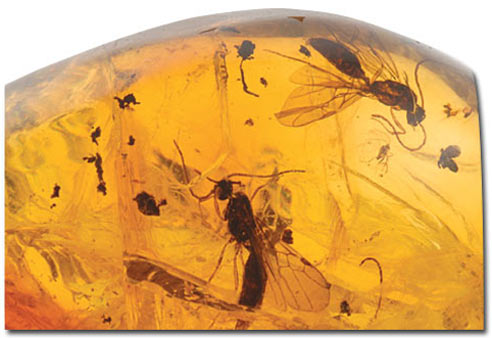 |
A 20- to 15-million-year-old midge preserved in amber. |
The most common, widespread process of fossilization is known as permineralization or mineralization. During this process the organism is replaced by minerals in the liquid in the soil in which the body is immersed. During the process of mineralization, the following stages take place:
First, it is essential that by being covered in soil, mud or sand, the body of the dead organism should immediately be protected from contact with the air. Over the following months, new layers of sediments are laid down over the buried remains. These layers act as a thickening shield, protecting the animal's body from external agents and physical wear. Many more layers form, one atop the previous ones; and within a few hundred years the animal's remains lie several meters beneath the surface of the land or sea or lake bottom. As more time passes, structures such as the animal's bones, shell, scales or cartilage slowly begin their chemical breakdown. Underground waters begin to infiltrate these structures, and the dissolved minerals contained in these waters—minerals such as calcite, pyrite, silica and iron, which are far more resistant to erosion and chemical breakdown—gradually replace the chemicals in the tissues. Thus over the course of millions of years, these minerals give rise to an exact stone copy by replacing the tissues in the organism's body. Finally, the fossil comes to possess the exact shape and external form as the original organism, although now converted into stone.
 |
This dragonfly trapped in mud may one day become fossilized and will reach the future generations as evidence that evolution has never happened. |
Various situations may be encountered during mineralization:
1. If the skeleton is completely filled with liquid solution and breakdown takes place at a later stage, then the internal structure gets fossilized.
2. If the skeleton is totally replaced by a different mineral from the original, a complete copy of the shell emerges.
3. If an exact template or "mould" of the skeleton forms due to pressure, then the remains of the skeleton's external surface may remain.
In plant fossils, on the other hand, it is carbonization caused by bacteria that applies. During the carbonization process, oxygen and nitrogen are replaced by carbon and hydrogen. Carbonization takes place by breaking down the tissue molecules by bacteria through changes in pressure and temperature or various chemical processes, causing chemical changes in the structure of the protein and cellulose in such a way that only carbon fibers remain. Other such organic materials as carbon dioxide, methane, hydrogen sulphate and water vapour disappear. This process gave rise to the natural coal beds that formed from the swamps that existed during the Carboniferous Period, 354 to 290 million years ago.
Fossils sometimes form when organisms are submerged in waters rich in calcium and get coated by minerals such as travertine. As the organism decays, it leaves behind traces of itself in the mineral bed.
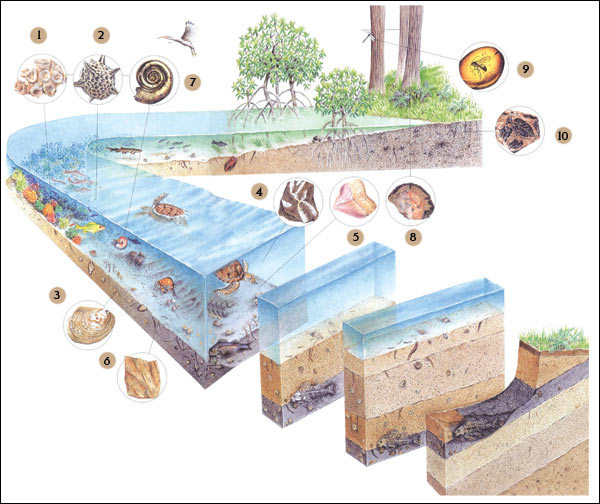 |
1. Reef: Calcareous sea animals that form the reef. |
 |
This fossil fish, 50 million years old, is evidence that fish have always remained as fish. |
 | |
At times, fragile organisms may also get fossilized under extraordinary conditions. | |
 | |
The skin and scales of this fish from the Triassic Period (250 to 203 million years ago) are fossilized with all their details intact. This sample reveals that fish had the same scale structure 250 million years ago. |
An organism's surroundings and environmental conditions also play a major role in fossil formation. One can predict whether or not fossilization will take place on the basis of an organism's surroundings. For example, in terms of fossil formation, underwater environments are more advantageous than dry land ones.
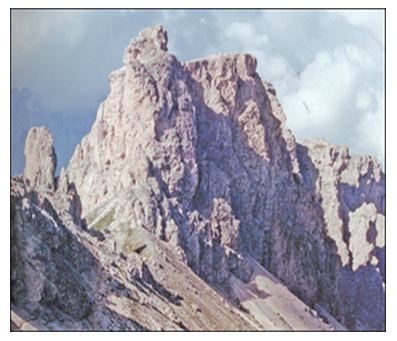 | |
THE GREATEST SPONGE REEF ON EARTH | |
The complete fossilization of a living thing's soft parts, even including fur, feathers or skin, is encountered only rarely. Remains of some soft-tissued life forms of the Precambrian Period (dating back 4.6 billion to 543 million years ago) have been very well preserved. There are also soft-tissue remains that permit internal structures from the Cambrian Period (543 to 490 million years ago), to be examined in addition to hard-tissue remains of living things right down to the present day. Fossil remains of animal fur and hairs preserved in amber, and fossil remains dating back 150 million years are other examples that permit detailed investigation. Mammoths compacted in Siberian ice packs or insects and reptiles trapped in amber in Baltic forests have also become fossilized together with their soft-tissue structures.
Fossils can vary considerably in terms of size, according to the type of organism preserved. Very different fossils have been obtained from the fossilized microorganisms to giant fossils from animals that lived together as groups or herds, in a communal lifestyle. One of the most striking examples of such giant fossils is the sponge reef in Italy. Resembling a giant hill, this reef is composed of 145-million-year-old limestone sponges that developed at the bottom of the ancient Sea of Tethys, and later rose up as the result of the movement of tectonic plates. It contains specimens of the life forms living in sponge reefs during the Triassic Period. The Burgess Shale in Canada and Chengjiang in China are among the largest fossil beds containing thousands of fossils from the Cambrian Period. The amber beds in the Dominican Republic and along the western shores of the Baltic Sea are other major sources of fossil insects. The Green River fossil beds in the U.S. state of Wyoming, the White River fossil beds in Central America, the Eichstatt beds in Germany and the Hajoula fossil beds in Lebanon are other examples that can be cited.
Just as with the living species, fossils too are studied under sections referred to as "kingdoms." In the 19th century, fossils were grouped together under two basic categories: either plants or animals. Subsequent research and discoveries made it necessary for other main fossil groups to be established, including for life forms such as fungi and bacteria. Under the fossil classification developed in 1963, fossils began to be studied in the form of five separate kingdoms:
1. Animalia – fossils from the animal kingdom, of which the oldest known specimens date back 600 million years.
2. Plantae – fossils from the plant kingdom, of which the oldest known specimens date back 500 million years.
3. Monera – fossils of bacteria with no nucleus, the oldest known specimens dating back 3.9 billion years.
4. Protoctista– fossils of single-celled organisms. The oldest known specimens date back 1.7 billion years.
5. Fungi – fossils of multi-celled organisms, of which the oldest known specimens date back 550 million years.
The first basic information regarding the Earth's crust began to be acquired in the late 18th and early 19th centuries, during the buildings of railways and tunnels. William Smith, a British tunnel builder, saw that there were rocks along the North Sea coast similar to those unearthed in Somerset during building work that dated back to the Jurassic period (206 to 144 million years ago). With the rock and fossil specimens he collected from one end of the country to the other, Smith produced the first geological surface map of England. In addition, based on rock specimens in his possession, he also drew underground geological maps for some regions, which made a major contribution to the advancement of modern geology and to determining the Earth's geological time frame. Thanks to the information contained in his maps, the nature and contents (iron seams, coal, etc.) of the strata immediately beneath the surface could be known, even if the rocks themselves were covered in vegetation.
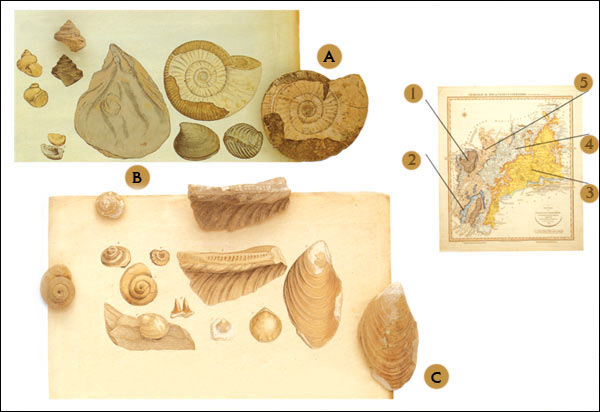 |
The first maps drawn by William Smith, the founder of British geology, contributed greatly to the development of modern geology. |
Fossils played a vital role in the acquisition of all his information. The geological time frame from the Precambrian Period to the Quaternary period was drawn up using the data indicated by fossil beds, and is still in use today. Thanks to investigations of rock structures, the stages undergone by the Earth at different periods were identified, and the fossils inside rocks provided information about the organisms that had existed during different periods. Combining these two together produced a chronology, according to which the history of the Earth is separated into two eons, with those eons being subdivided into eras and eras into periods.
 |
In order to make natural history more comprehensible, geologists and paleontologists divided the history of the Earth into geological periods. While determining these periods, the formation of rocks, their ages and the fossils they contain play an important role. 1- Cambrian Period (543 to 490 million years ago) 2- Ordovician Period (490 to 443 million years ago), 3- Silurian Period (443 to 417 million years ago), 4- Devonian Period (417 to 354 million years ago), 5- Carboniferous Period (354 to 290 million years ago), 6- Permian period (290 to 248 million years, 7- Triassic Period (248 to 206 million years ago), 8- Jurassic Period (206 to 144 million years ago), 9- Cretaceous Period (144 to 65 million years ago), 10- Quaternary Period, 11- (65 million years ago to today) |
1. The Precambrian Eon (4.6 billion to 543 million years ago)
The Precambrian is regarded as the oldest and also the longest period in the Earth's history and is subdivided into various eons and eras. The period between 4.6 and 3.8 billion years ago is referred to as the Hadean Eon. At this time, the Earth's crust was still forming. The Archean Eon was between 3.8 and 2.5 billion years ago, followed by the Proterozoic Eon, between 2.5 billion to 543 million years ago. In the fossil record, there are various traces of single- and multi-celled organisms from these periods.
2. The Phanerozoic Eon (543 million years to the present day)
Phanerozoic means "visible or known life." The Phanerozoic Eon is studied under three separate eras: the Paleozoic, the Mesozoic and the Cenozoic.
This era, which lasted some 300 million years, is the first and longest part of the Phanerozoic Eon. Throughout the course of the Paleozoic, the climate was generally humid and temperate, though ice ages did take place from time to time.
 | 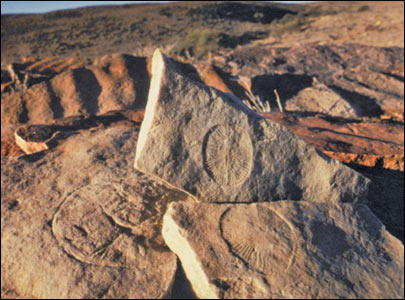 |
Rocks from the Precambrian Period in Greenland (4.6 billion years to 543 million years ago). (left) The Ediacara Hills in Australia contain rocks from the Precambrian Era. The 570- to 543-million-year-old jellyfish fossils pictured are also found in Ediacara. These fossil records dating back to hundreds of millions of years deny the claim of "evolutionary process." According to the unscientific claims of evolutionists: | |
The Paleozoic Era is studied under six distinct periods, the Cambrian, Ordovician, Silurian, Devonian, Carboniferous and Permian:
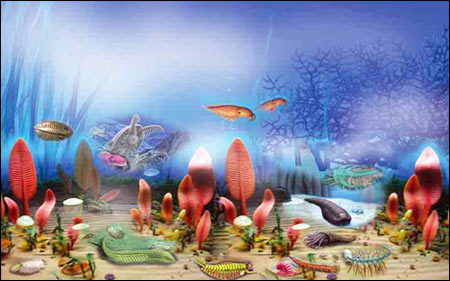 A drawing of the creatures from the Cambrian Period. |
This period is the geological age in which all the basic living groups (or phyla) still alive today, and even more that subsequently became extinct, appeared suddenly. (Phylum is the largest category after kingdom in the classification of living things. Phyla are determined on the basis of the numbers and variety of living things' organs and tissues, their bodily symmetry and internal organization. The number of today's phyla has been determined as 35, but around 50 existed during the Cambrian Period.)
The emergence of species was so sudden and so wide-ranging that scientists gave it the name of the "Cambrian Explosion." The evolutionist paleontologist Stephen Jay Gould has described this phenomenon as "the most remarkable and puzzling event in the history of life", while the evolutionist zoologist Thomas S. Ray writes that the origin of multi-cellular life is an event of comparable significance to the origin of life itself.
When one considers information about the Cambrian explosion as provided by the science of paleontology, it clearly confirms God's creation and refutes the theory of evolution. The Precambrian age before the Cambrian was populated mainly by single-celled organisms, with just a few multi-celled life forms with few specific characteristics and lacking such complex structures as eyes and feet. Therefore, no evidence supports the imaginary evolutionary transition to Cambrian life forms, and not a single fossil that can be claimed to represent their supposed forerunner. In this barren environment, inhabited by single-celled organisms, an astonishing variety of life with exceedingly complex features suddenly came into being. Through this explosion, moreover, there emerged life forms separated from one another by very distinct structural characteristics. Fossils reveal very profound gaps in terms of both relatedness and complexity among organisms living in the Precambrian and those in the Cambrian. So striking are these gaps that evolutionists, who need to be able to prove continuity among living groups, have been at a loss to establish any familial relationships among these phyla, on even a purely theoretical level.
The Cambrian Period shows that right at the beginning, very different life forms with exceedingly complex structures emerged suddenly—and in fact, this is exactly what is taught by creation. The origin of the perfect structures possessed by living things is God's creation. In the fossil record, these perfect structures appear in a flawless form without exhibiting any deficient, semi-completed or still-functionless stages of the kind predicated by the chance-based theory of evolution.
 A drawing of the creatures from the Ordovician Period |
In this period, a large number of marine invertebrates lived. The fossil record has revealed a great wealth of families of marine creature during the Ordovician Period. There are also terrestrial plant fossils dating back to the same period. During the Ordovician Period, global climate changes caused by ice ages resulted in a number of species becoming extinct. This state of affairs is described as the "Ordovician extinctions."
Some life forms that existed during the Ordovician Period are still around today. One is the horseshoe crab. A 450-million-year-old fossilized horseshoe crab shows that nearly half a billion years ago, these creatures had exactly the same features and complex equipment. The oldest known and most perfect fossilized water spider also belongs to the Ordovician Period (425 million years) and is another important proof that living things have remained unchanged for long ages. In a period when—according to the Darwinist scenario—living things should have been undergoing evolution, these remains reveal that evolution never took place in any manner whatsoever.
 |
These rocks in Newfoundland show the transition from the Cambrian to the Ordovician Period. (left) A 450-million-year-old fossil horseshoe crab, no different from those crabs of our day. (right) |
As temperatures rose again, the glaciers melted and flooded some continents. There are many fossils of land plants dating back to this period, as well as fossilized echinoderms such as the sea lily, arthropods such as sea scorpions, and various species of jawless fish and armored fish, as well as a number of species of spider.
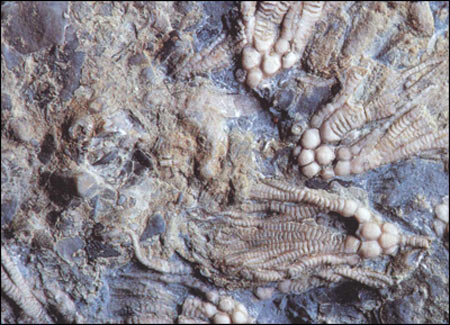 Crinoid from the Silurian Period |
Countless fossil fish date back to this period. During the Devonian, a kind of "mass disappearance" took place and certain species became extinct. This mass disappearance affected coral reefs, with stromatoporoids (a form of reef-forming coral) disappearing entirely.
But there is no difference between the thousands of fossil fish that lived during the Devonian Period and many species of fish living today. This, once again, is important evidence that living things have undergone no changes over the course of millions of years, and that there can be no question of their having evolved gradually.
Also known as the Coal Age, this period is subdivided into two separate periods, the Lower Carboniferous or Mississippian and the Upper Carboniferous or Pennsylvanian. Land rising and falling, resulting from collisions between continents, and rises and falls in sea levels linked to the polar ice caps were significant events that shaped the world during this period. Many fossils of marine and terrestrial life forms date back to the Carboniferous Period. The coelacanth, which Darwinists for many years depicted as a supposedly intermediate form, is still alive today, proving the invalidity of this claim. It has undergone no change over the course of millions of years and has never undergone "evolution." Contrary to Darwinists' claims that the coelacanth was a "missing link" that corroborated evolution, it is actually an example of a "living fossil" that totally refutes evolution. The coelacanth had been the subject of countless forms of evolutionist speculation, but its emergence as a living fossil presents evolutionists with a major dilemma.
 |
Coelacanth of our day and a Coelacanth fossil, 410 million years old |
 |
355- to 295-millionyear-old spider fossil |
At the end of the Permian Period, another mass disappearance took place that represented the final end of the Paleozoic Era. The fossil record shows that during this huge disappearance, 90%-95% of living species became extinct. Nonetheless, some Permian life forms have survived right down to the present day. Fossil specimens from the Permian such as dragonflies and spiders prove that evolution never took place at any time in the past.
The Mesozoic Era is divided into three separate periods: the Triassic, Jurassic and Cretaceous. It was during this era that dinosaurs lived and became extinct.
The Mesozoic Era began with the Triassic Period. A large number of Triassic fossils from all over the world show a wide variety of both marine and terrestrial life forms. As is the case with all other periods, there appears not a single intermediate fossil of the kind that evolutionists hope for.
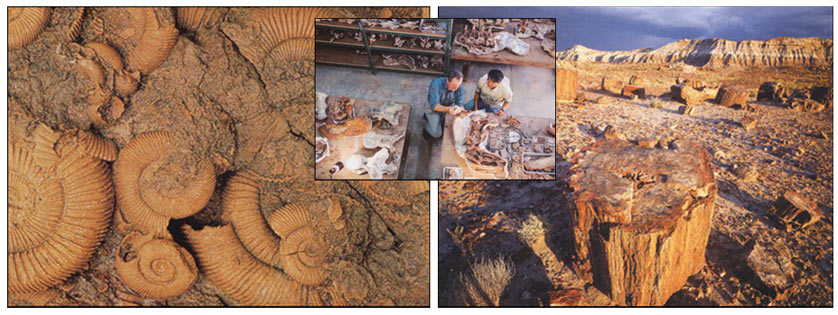 |
The Petrified Forest in Arizona—of fossilized, opalized logs—is one of the most famous structures of the plants from the Triassic Period. This forest, consisting of trees now known as the Chilean araucaria is evidence that plants have not evolved. These trees, which lived 248 to 206 million years ago, are no different from ones living today. |
This part of the Mesozoic saw large numbers and varieties of dinosaurs. At the end of the Jurassic, some ammonites, sea sponges, oyster and mussel species had become extinct.
But many life forms have survived unchanged since the Jurassic—in other words, without undergoing any form of evolution. The fossil record is full of examples of such creatures. One of the earliest known fossil crocodiles, for instance, is around 200 million years old. There are also examples of fossilized Tuatara lizards that are more than 200 million years old. The many fossil shrimp dating back to the Jurassic Period all possessed exactly the same perfect systems and complex structures as they do today.
 |
A 200-million-year-old tuatara lizard, and the same lizard alive today. (left) |
 |
A 206- to 144-million-year-old shrimp fossil. It is no different from the shrimp living in our day. |
 A fish between 146 and 65 million years old, and a fossil bat uncovered in France. |
This, final stage of the Mesozoic, is known as the age in which the dinosaurs became extinct, as did a large number of terrestrial reptiles and plant species.
On the other hand, a great many species of aquatic animals such as starfish, crabs, some species of fish, water scorpions, spiders, dragonflies, turtles and crocodiles, and various plant species managed to survive down to the present day. Fossil specimens such as a 135-million-year-old starfish, a 140-million-year horseshoe crab, and a 125-million-year ginkgo tree leaf are just a few of the proofs of this. Despite the intervening millions of years, these life forms still possess the same complex systems, totally invalidating Darwinist claims regarding natural history.
 |
This 54- to 37-million-year-old crocodile fossil was found in Germany. |
The Cenozoic Era, in which we are still living, began with the end of the Cretaceous Period. Until recently, geologists and paleontologists divided the Cenozoic into two separate periods of unequal length: the Tertiary and the Quaternary. The Tertiarycomprised a time frame from 65 million to 1.8 million years ago, and the Quaternary encapsulated the last 1.8 million years. Recently, however, the Cenozoic Era has been divided into three separate periods. Under this new system, its three components are the Paleogene, the Neogene and the Quaternary.
The Cenozoic Era's fossil record contains large numbers of specimens that, just as with other ages, show that the theory of evolution—which maintains that living things descended by chance from a common ancestor—is not true.
One distinguishing feature of the fossil specimens obtained from all these geological periods is that the species in question never underwent any changes. To put it another way, whenever a species first appears in the fossil record, it preserves its same structure for tens of millions of years, until it becomes extinct or else survives until the present day—again, without experiencing any change. This is clear evidence that living things never underwent evolution.
The fossil history of species definitively and clearly refutes the theory of evolution. It is Almighty God, with His sublime power and boundless knowledge, Who creates completely different living species out of nothing and makes the world suitable for life.
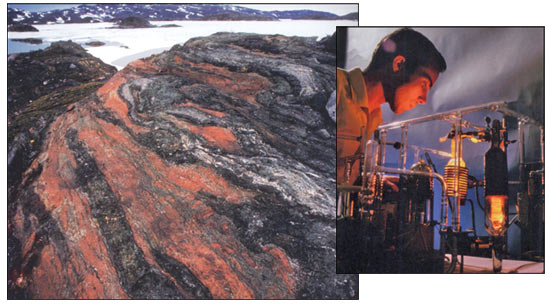 |
The world's oldest rocks are in Greenland, between 3.9 and 3.8 billion years old. (left) |
Fossils are widely dispersed just about everywhere on Earth. Almost no fossils are encountered in some types of rock, but large numbers are found in others. Geologists have divided rock types into three main groups:
1. Igneous
2. Sedimentary
3. Metamorphic
The igneous category includes granite or basalt-type rocks formed by the cooling of magma present in the depths of the Earth, or else emitted by volcanoes in the form of molten lava. Sedimentary rocks form when sand, silt, mud, and other small particles or substances carried in water are deposited on top of one another. Metamorphic rocks are igneous or sedimentary ones that have undergone structural changes due to high temperature and pressure deep in the Earth.
Few fossils are generally encountered in igneous seams. The rare examples discovered are fossils that have resulted when a plant or animal gets trapped inside molten lava. Very few fossils can survive the high temperatures and pressures that transform sedimentary strata into metamorphic rock. Almost all fossils are found in sedimentary seams or deposits.
Nearly all sedimentary rocks are formed by substances carried by wind or water or else from the erosion of still other rocks. Some forms, such as coal, are made of plant or animal remains. Clastic is the name given to sedimentary rock formed by minute particles or grains. Sandstone and schist are examples of such rocks. If there has been dissolution in the substances transported, then due either to chemical solution or vaporization, "organic" sedimentary beds form. Examples of such rocks are limestone and dolomite. In general, sedimentary rock seams are a mixture of clastic and organic seams. Fossils are usually seen in shales, schists, sandstone and limestone formed from calcium carbonate.


The tools used to collect fossils are simple ones such as those used by geologists: hammers, trowels, various cutting implements, compasses, brushes and sieves.
Fossils sometimes appear on the surface when eroded out of the soft rock strata around them. In such cases, it is sufficient to clean the fossils with a brush. However, fossil collecting is not usually that easy. The rocks inside which they are concealed are generally very hard, and it can take hours to extract a fossil from its rocky matrix. First, it is important to determine from what point the rock should be broken. Fracture lines are identified in the light of the rock bed itself. Every type of rock is broken in different ways. Schists, for example, have layers through which fracture lines can be established. Chalk, on the other hand, offers no such layers. At the same time, it is very important to watch for such indications as color changes or structural differences, if the fossils contained inside are not to be damaged.
After the fossil has been extracted from the rock, it undergoes a number of different processes. It must be protected and reinforced while being transported to the laboratory where it will be examined. One of the methods employed is to stabilize the fossil with chemical adhesives. Plaster casts are used for very large fossils. Those parts of the fossil that will be at risk during transportation are wrapped in dampened newspaper and then dipped in plaster.
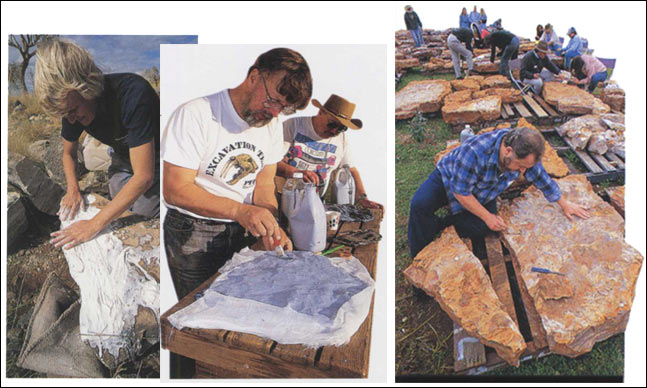 |
Collecting sedimentary rocks and stones and carefully breaking open those ones predicted to consist fossils is an important stage of collecting fossils. (right) |
The fossil then must be cleaned in order for all its details to become visible. If the fossil is harder than the rock surrounding it, then the cleaning process is a great deal easier. However, if the fossil has a softer structure, then chemical substances need to be used. One of the most commonly used methods is to clean away the matrix with acid. This enables all the fossil's details to be brought out. In some situations—particularly when the fossil is very delicate and possesses the same structure as the rock surrounding it—X-rays and computer-scanning devices are used to determine the fossil's structure before it is extracted from its location.
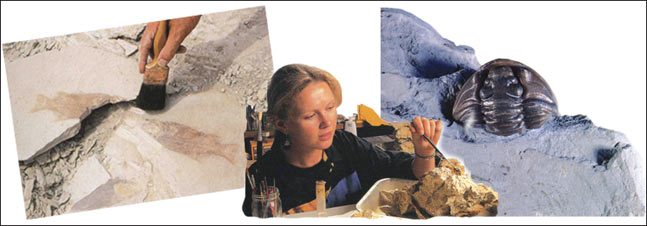 |
FOSSIL CLEANING BY ACID |
 Charles Darwin |
Fossils unearthed to date possess two very important features, both of which conflict with the claims of the theory of evolution:
1. Stasis: Species exhibit no changes throughout the course of their existence on Earth. Whatever the structure they display when they first appear in the fossil record, they have that same structure when they finally disappear from it. Morphological (shape) change is generally minor and follows no specific direction.
2. Sudden Appearance: No species ever emerges gradually through differentiation from its alledged forebears; it appears suddenly and "fully formed."
The significance of these two points is that living things were created, with no process of evolution and no intermediate stages to go through. They did not subsequently acquire the characteristics they possess, but had them since the moment of their creation.
Darwin himself knew that the fossil record refutes his theory of evolution, but Darwinists have been reluctant to ever admit it. In the chapter titled "Difficulties on Theory" in his book The Origin of Species, Darwin admitted that the fossil record could not be explained in terms of the theory of evolution:
Why, if species have descended from other species by insensibly fine gradations, do we not everywhere see innumerable transitional forms? Why is not all nature in confusion instead of the species being, as we see them, well defined? ... But, as by this theory innumerable transitional forms must have existed, why do we not find them embedded in countless numbers in the crust of the earth?… Why then is not every geological formation and every stratum full of such intermediate links? Geology assuredly does not reveal any such finely graduated organic chain; and this, perhaps, is the most obvious and serious objection which can be urged against my theory.(Charles Darwin, The Origin of Species, Oxford University Press, New York, 1998, pp. 140, 141, 227)
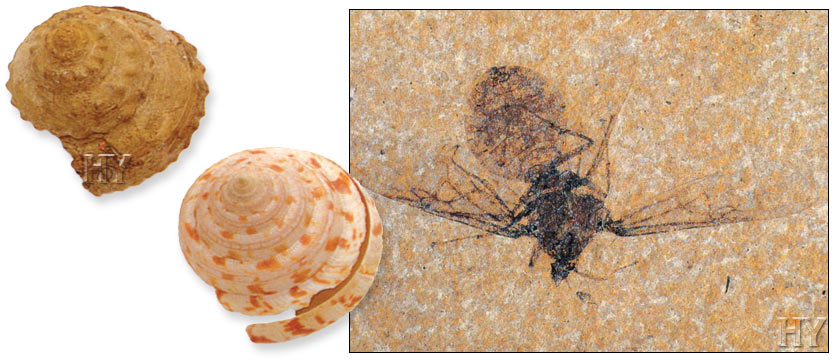 |
The oldest known fossil specimens of the snail pictured belong to the Jurassic Period (206 to 144 million years ago). The first samples of the class of living beings to which this species belongs have existed since the Cambrian Period (543 to 490 million years ago). Snails have remained the same for hundreds of millions of years, revealing the invalidity of evolution. (left) |
The argument that Darwin proposed in the face of the lack of intermediate form fossils—to the effect that "there are no intermediate forms now, but they may be found through subsequent research"—today no longer applies. Present-day data show that the fossil record is extraordinarily rich. Based on hundreds of millions of fossil specimens obtained from different regions of the world, some 250,000 separate species have been described—many of which bear an extraordinary resemblance to the approximately 1.5 billion species alive today. Given the absence of any intermediate form despite such a wealthy fossil record, it is impossible any such intermediate forms will emerge from new excavations.
 |
All the living creatures in the fossil record appear intact and in their perfect forms. For instance, before crocodiles and squirrels, there exist no fossils belonging to any strange creature partly resembling a crocodile, and in other parts to a squirrel or other living creatures. Squirrels have always remained squirrels, and crocodiles have always remained crocodiles. All these facts reveal that the claim of the theory of evolution, that "Living beings have gradually evolved over millions of years of time" is simply a product of imagination. |
The fossil record offers not a single example of an "intermediate form" that evolutionists can use as evidence, but does provide millions of specimens that demonstrate the invalidity of evolution. The most important of these are "living fossils," of which living specimens are in existence today. They can be seen from the fossil record to have lived in differing geological periods, and are proof of creation, since no difference exists between the living things of hundreds of millions of years ago and present-day specimens. Darwinists are helpless in the face of this situation.

 |
There are many species of plants whose structures have remained unchanged since the Triassic Period (248 to 206 million years ago). One of these is a ginkgo tree. The fossil pictured is from the Jurassic Period (206 to 144 million years ago). |
The evolutionist Niles Eldredge admits that they have no explanation to offer on the subject of living fossils, which represent just one of the countless secrets evolution is unable to unravel:
... there seems to have been almost no change in any part we can compare between the living organism and its fossilized progenitors of the remote geological past. Living fossils embody the theme of evolutionary stability to an extreme degree.... We have not completely solved the riddle of living to an extreme degree... We have not completely solved the riddle of living fossils. (http://www. nwcreation.net/fossilsliving.html)
The "secret" that Niles Eldredge attempts to unravel is actually a perfectly clear fact. Living fossils prove that species did not undergo evolution, but were created. However, Darwinists seek to ignore this fact out of ideological concerns and persist in keeping alive the dogmas of 150 years ago.
But the facts can now be determined much more clearly than in Darwin's day. The number of people who understand and choose to go along with the facts is rising, while those who believe in fairy tales and never seek to question them are ever fewer in number. Facts can no longer be concealed and swept aside, as was the case in Darwin's time. Genetics, microbiology, paleontology, geology and all other branches of science constantly reveal a truth that Darwin and the supporters of Darwinism never wanted and perhaps never expected—the fact of creation.
 |
The irrational and unscientific claims that Darwinists make, the frauds they perpetrate to deceive the public, and the propaganda they employ to mislead people are only signs of their despair. Subsequent generations will be amazed at how people once believed in the Darwinist myth. Because all scientific findings show the manifest fact that evolution never happened, and that God created the universe and all living things.
Among His signs is the creation of the heavens and Earth and all the creatures He has spread about in them. And He has the power to gather them together whenever He wills. (Surat ash-Shura, 29)
[God is] the Lord of the heavens and the Earth and everything in between them, if you are people with certainty. There is no deity but Him—He gives life and causes to die—your Lord and the Lord of your forefathers, the previous peoples. Yet they play around in doubt. (Surat ad-Dukhan, 7-9)